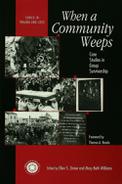Book Description
When a Community Weeps provides a model for effective counselor intervention in bereaved communities. Individual chapters have been written by traumatologists, psychiatrists, psychologists, social workers, and family members who have witnessed the effects of traumatic events first hand. Each chapter presents a specific traumatic event and gives perspectives on how these events affected the individuals involved as well as the community as a whole.
Table of Contents
- Cover
- Halftitle
- Title
- Copyright
- Dedication
- Contents
- Contributors
- Foreword
- Preface
- Acknowledgments
- Introduction
- Chapter 1: The Connection Between Grief and Trauma: An Overview
- The Context of Tragedy
- Key Definitions
- What is a Community?
- Models of Bereavement and Grief
- PTSD and Traumatic Events
- Healing Within a Community
- Conclusions
- References
- Part One: Humanmade and Natural Disasters
- Chapter 2: The Challenger Disaster: Group Survivorship on a National Landscape
- The Shuttle Challenger: Mission 51-L
- Group Survivorship and the Loss of Challenger
- Personal Word and Summary
- References
- Chapter 3: The Estonia Disaster: National Interventions, Outcomes, and Personal Impacts
- The Disaster of September 28, 1994
- Immediate Responses to the Disaster
- Memorials, Investigations, and Conclusions
- Conclusions and Impact
- References
- Chapter 4: The Kempsey Bus Disaster: The Effects on Australian Community Rescuers
- The Kempsey Bus Disaster
- Reflecting on a Group Crisis
- References
- Chapter 5: Coping Through Meaning: The Community Response to the Earthquake in Armenia
- The Day the Land Moved: December 7, 1988
- The Republic of Armenia
- Disaster Theory and Response
- Psychosocial Response of the Armenian Community
- Conclusion
- References
- Chapter 6: The Great Hanshin-Awaji Earthquake: Adapted Strategies for Survival
- The Disaster Strikes
- Mental Health Needs
- Dealing With Death: Interruption of Normal Rituals
- Community Outcomes
- A Personal Response to Kobe
- Conclusions
- References
- Part Two: The Loss of Leaders and Heroes
- Chapter 7: Death of a Leader: The Social Construction of Bereavement
- Background: Before the Assassination
- The Assassination
- Bereavement: The Stages Model
- Following the Assassination
- Stages of Individual and Social Grief: A Comparison
- Creation and Construction of Rituals
- Sociopsychological Perspective: Collective Grief in Israeli Society
- The “Wounded Observers”: A Personal Account
- Concluding Remarks and Implications
- References
- Chapter 8: The Death and Rebirth of a Hero: Mickey Mantle’s Legacy
- An American Hero
- The American Dream
- The Diagnosis
- Reality and the Dream
- Redemption
- The Transplant
- The System
- Education
- The Double Bind
- Giving Something Back
- The Wrap Up
- “Be a Hero”
- Creating Good from Grief
- Conclusion
- References
- Part Three: Terrorism and Political Action
- Chapter 9: The Terrorist Bombing in Oklahoma City
- Risk Factors in Posttrauma Responses
- The Victim and Survivor Groups in Oklahoma City
- Interventions with Survivor Groups
- Rituals for Survivors and Families of the Deceased
- The 1-Year Anniversary
- Reflections and Conclusions
- Synopsis
- References
- Chapter 10: The Threat to Belonging in Enniskillen: Reflections on the Remembrance Day Bombing
- The Essential Attributes of a Community
- The Implications of the Remembrance Day Bombing: How the Community Responded
- Providing Support and Responding to a Community Disaster
- Final Remarks
- References
- Chapter 11: The Significance of Unforeseen Death in a Community on the Brink
- The Body, the Sustenance, and the Home: Central Development Processes
- Coming to Terms with Trauma: Mali’s Death at Gilgal
- References
- Synopsis
- Chapter 12: Summary and Incorporation: A Reference Frame for Community Recovery and Restoration
- Pretrauma Period
- Trauma Period
- Primary Intervention Period
- Secondary Adjustment Period
- Posttrauma Period
- Index
